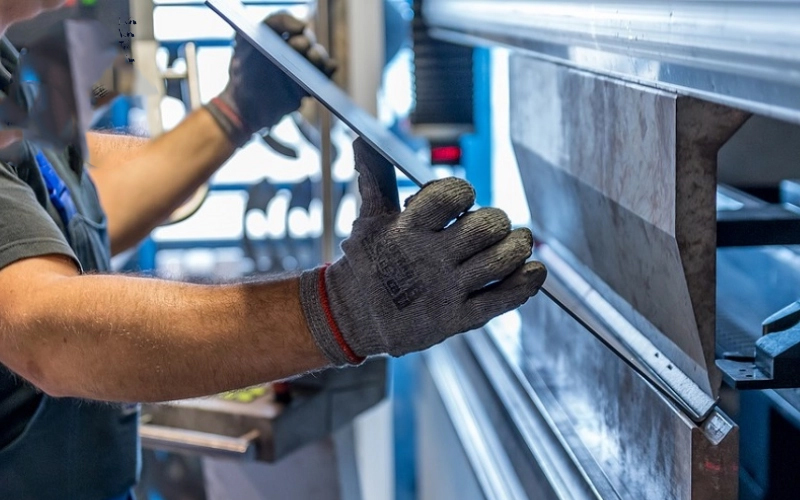News
What is Stainless Steel Folding? Learn the Process and Advantages and Disadvantages of Stainless Steel Folding
In the modern industrial world, stainless steel (inox) has become an indispensable material, playing a crucial role in various sectors from construction, food production to healthcare, and transportation. Thanks to its corrosion resistance, high durability, and aesthetic appeal, stainless steel is widely applied, creating durable and high-quality products.
Have you ever wondered, ‘What is stainless steel folding?’ This is a unique metal fabrication technique that allows complex shapes to be formed from flat stainless steel sheets, opening up countless design and application possibilities.
This article provides a comprehensive overview of stainless steel folding, from basic definition, methods of execution, detailed processes, practical applications to reference pricing. We, at Trong Tin Stainless Steel, aim to provide you with valuable insights into this fabrication technique, helping you make the most suitable choice according to your needs.
1. What is stainless steel folding?

Stainless steel folding handle
Stainless steel bending is a sheet metal processing process in which stainless steel is shaped into the desired shape through the use of impact force. The nature of this process uses a bending machine, combined with a bending die to create bending angles and curves on the stainless steel sheet according to technical design.
To visualize, you can consider stainless steel bending as the process of “bending” stainless steel according to a mold. Instead of cutting away material like the cutting method, or joining parts together like the welding method, stainless steel bending keeps the seamlessness of the stainless steel sheet, only changing its shape.
Distinguishing stainless steel bending from other processing methods:
- Compared to cutting: Bending keeps the material intact, creating no waste, while cutting creates excess.
- Compared to welding: Folding creates a monolithic product without joints, increasing durability and aesthetics compared to welding.
- Compared with stamping: Bending is suitable for simple to complex shaped parts, small to medium quantity, while stamping is often used for mass production of similar parts..
Role of stamping :
The punching die plays a decisive role in determining the final shape of the stainless steel folding product. The punching die includes a punch and a mortar, designed to have the exact shape according to technical requirements. When the stainless steel sheet is placed between the punch and mortar, the force from the punching machine presses the punch down, bending the stainless steel sheet according to the shape of the die.
Terms related to stainless steel folding:
- Bending angle: The angle formed between two parts of the stainless steel sheet after bending.
- Radius of bend: Curvature of the bend angle.
- Bend length: Length of the bent stainless steel section.
- Bending force: Force required to bend stainless steel sheet.
Advantages of stainless steel bending method:
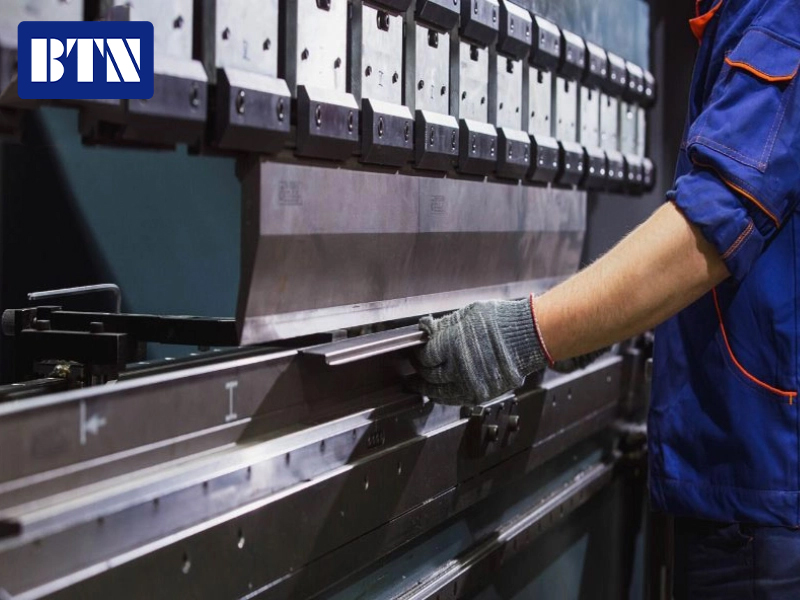
Stainless steel folding
- High precision: Modern press brake machines, especially CNC press brake machines, achieve accuracy up to 0.1mm, ensuring the final product meets strict technical requirements.
- Complex Forming: Stainless steel bending allows for complex 2D, 3D shapes to be created, meeting diverse design needs.
- Material saving: By not cutting material, stainless steel folding saves material costs and reduces waste.
- Increase product rigidity: The folding line increases product rigidity, helping the product withstand force better.
2. Stainless steel bending methods
Currently, there are many stainless steel bending methods, each method is suitable for different production requirements. Below are the three most common methods:
Bending by mechanical press:
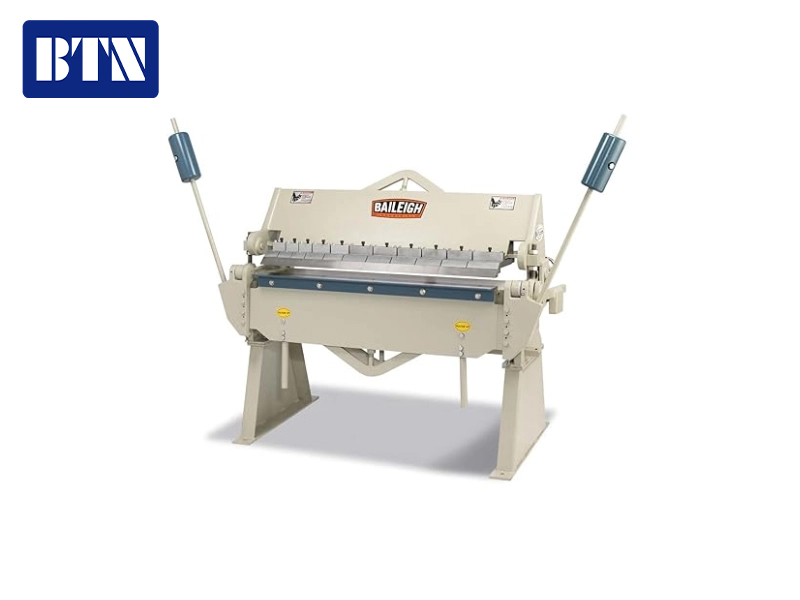
Bending by mechanical press brake
This is the traditional method, using a mechanical system (usually a crankshaft and connecting rod) to create the punching force.
- Advantages: Low investment cost, easy to operate and maintain.
- Disadvantages: Accuracy is not as high as other methods, difficult to create complex shapes, slow speed, high noise.
Hydraulic press brake:
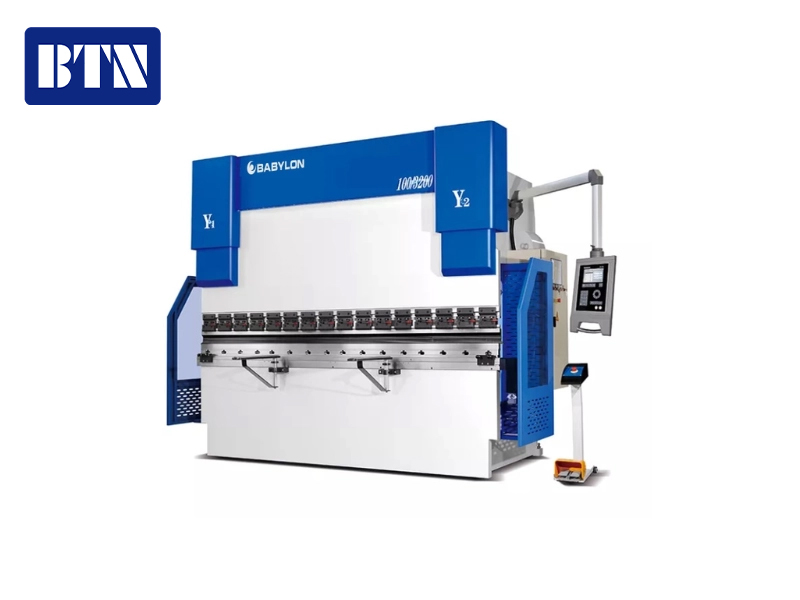
Hydraulic press brake
This method uses a hydraulic system to create the shaking force.
- Advantages: Large, stable bending force, can bend thick stainless steel plates, higher precision than mechanical bending machine, smoother operation.
- Disadvantages: Investment cost is higher than mechanical press, requires periodic maintenance of hydraulic system.
CNC (Computer Numerical Control) bending:
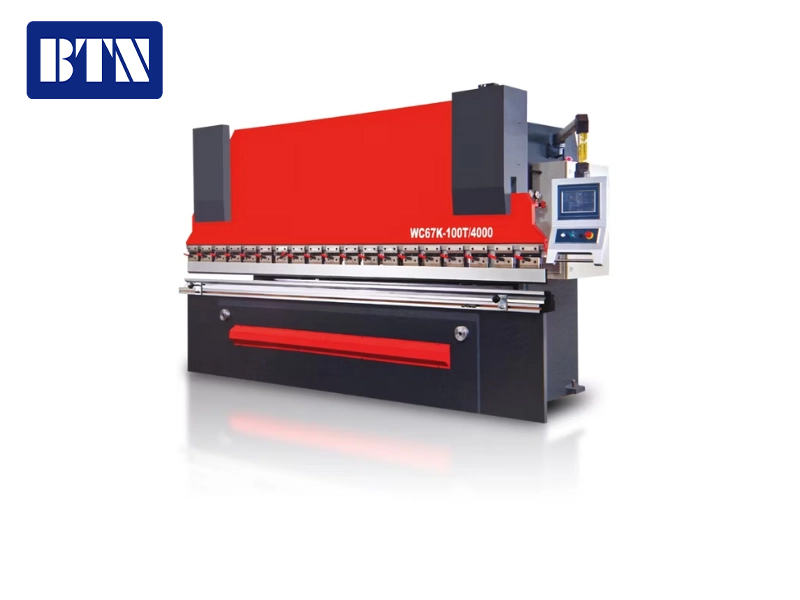
CNC bending machine
This is the most modern method, using computers to control the bending process.
- Advantages: Extremely high precision, virtually unlimited complex forming capabilities, fast speed, minimal human error, easy to change bending programs.
- Disadvantages: Very high investment cost, requires highly skilled operators, high maintenance costs.
3. Detailed stainless steel bending process
To ensure the quality of stainless steel bending products meets requirements, the process must be carried out methodically, following the following steps:
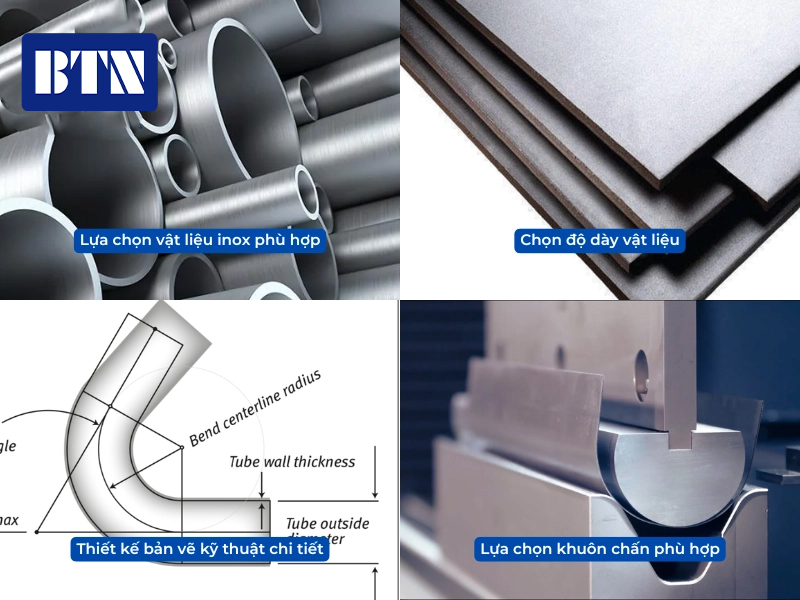
Detailed bending process
Choosing the right stainless steel material:
- Steel grade: Depending on the product application, it is necessary to choose the appropriate stainless steel grade (for example: 304, 201, 316). Each stainless steel grade has different chemical composition and mechanical properties, affecting corrosion resistance, durability, and machinability.
- Thickness: The thickness of the stainless steel plate must be suitable for the product’s load-bearing requirements, machine bending capacity, and at the same time affect the bending angle accuracy and curvature radius.
Detailed technical drawing design:
- Technical drawings must fully show information about the product’s shape, size, tolerance, bending angle, curvature radius, and hole location (if any).
- Drawings need to be carefully checked to ensure accuracy and technical feasibility.
Select the appropriate punching die:
- The stamping mold needs to have the appropriate shape and size for the product shape and thickness of the stainless steel sheet.
- The stamping die material needs to be highly hard and wear-resistant to ensure durability and accuracy of the stamping process.
Steps to perform bending:
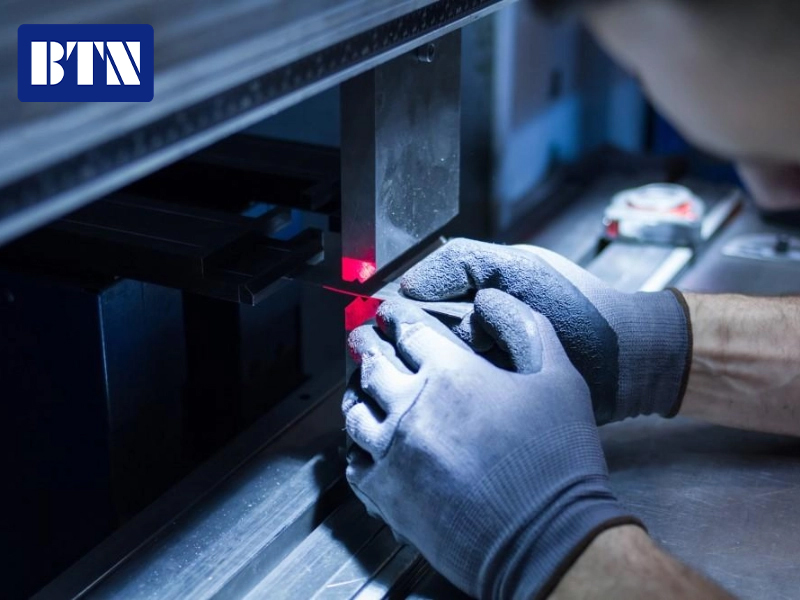
Perform urgent shock
Setting up the press brake parameters:
- Set the bending force, bending speed, and bending stroke to suit the material, stainless steel plate thickness, and product shape.
- This parameter needs to be adjusted precisely to avoid damaging the product, the mold, or endangering the operator.
Positioning stainless steel blanks on the machine:
- Stainless steel blanks need to be positioned accurately on the machine table, ensuring the bending position is correct according to the technical drawing.
- Use stopper to clamp stainless steel blank to avoid displacement of the bending process.
Perform the bending process:
- Start the press brake, perform the press brake according to the set program (for CNC press brake) or manual control (for mechanical and hydraulic press brake).
- Monitor the vibration performance, ensure the machine operates stably, without strange noises or strong vibrations.
Check and adjust after bending:
- Check the size, shape, bending angle, and curvature radius of the product after bending.
- Compare the technical drawing product, if there is any discrepancy, it is necessary to readjust the press brake parameters, blank position, or press brake mold.
Safety notes for urgent work:
- Wear goggles, gloves, protective clothing when working.
- Do not put your hands in the danger zone of the machine while it is operating.
- Comply with safety rules for operating the press brake.
- Ensure the press brake machine is regularly maintained and operates stably.
4. Applications of stainless steel folding in practice
Thanks to its flexibility, durability and aesthetics, stainless steel folding is widely used in many fields:
In the construction industry:

Applications of bending in construction
- Roofing, partitions, gutters, railings, stairs: Folded stainless steel creates durable products, resistant to harsh weather, bringing modern beauty to the project.
- For example, Bitexco Financial Tower (HCMC) uses folded stainless steel panels for the facade, creating unique lighting effects while increasing resistance to storms.
In the food industry:
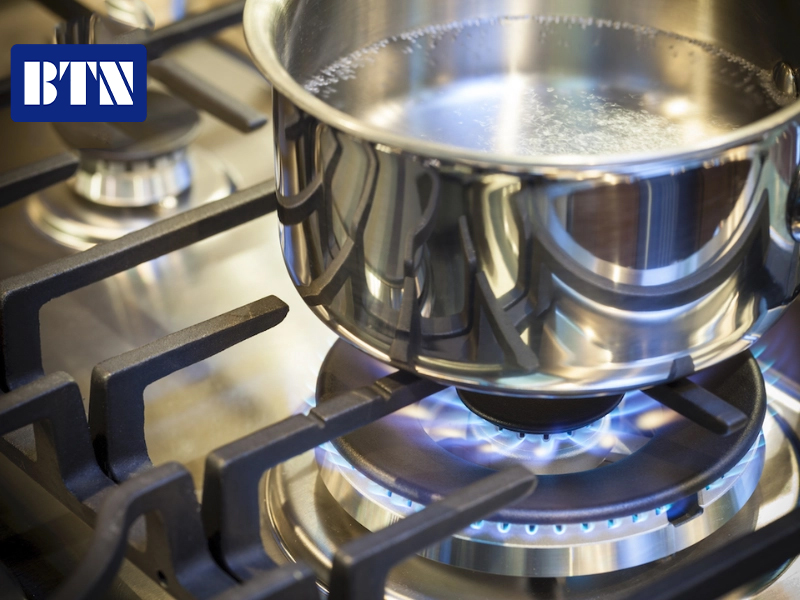
Applications of folding in the food industry
- Tables, chairs, shelves, cabinets, sinks, food processing equipment: Stamped stainless steel meets strict requirements for food hygiene and safety, is easy to clean, does not rust, and does not produce toxic substances.
- For example: Vinamilk factory uses folded stainless steel tanks to ensure milk quality during production.
In the medical industry:
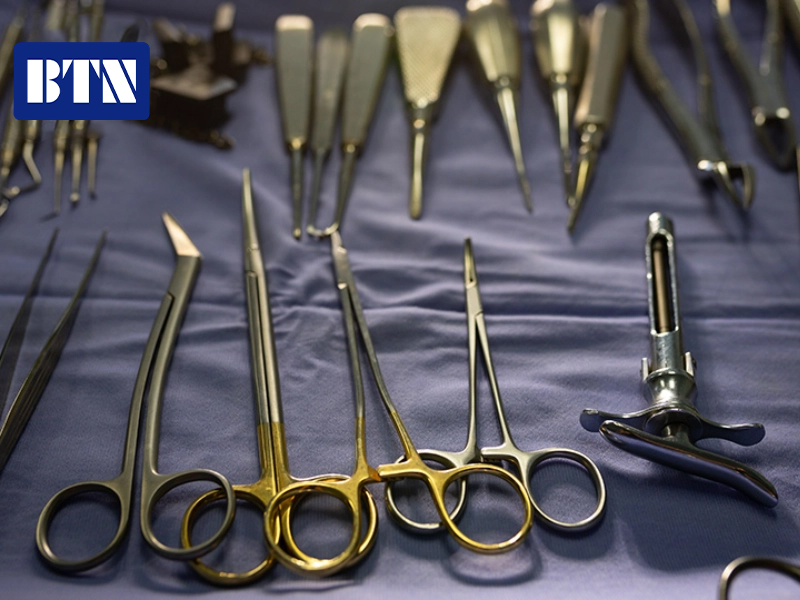
Applications of bending in the medical industry
- Operating tables, hospital beds, cabinets for instruments and medical equipment: Stamped stainless steel ensures sterility, easy to disinfect, not corroded by chemicals, meeting strict requirements of the medical industry.
- For example: Cho Ray Hospital uses folded stainless steel carts to transport medicine and medical equipment, ensuring hygiene and safety for patients.
In the transportation industry:
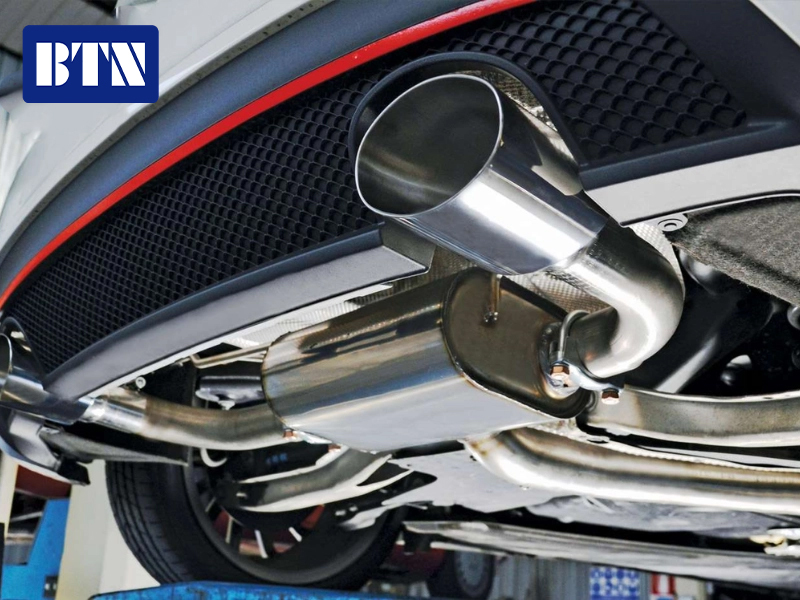
Applications of bending in the transportation industry
- Car body, trunk, interior details: Stamped stainless steel helps reduce vehicle weight, increase durability, anti-corrosion, and bring aesthetic beauty to the vehicle.
- For example: Samco buses use stamped stainless steel frames to increase rigidity and reduce the risk of accidents.
Other applications:
- Household appliances, interior decoration, fine art products: Stamped stainless steel creates products with diverse designs and models, meeting the increasingly high aesthetic needs of consumers.
- For example: The folding stainless steel decorative lamps are exquisitely designed, bringing a luxurious and modern beauty to the interior space.
5. Factors affecting the quality of stainless steel folding
To obtain quality stainless steel products that meet technical requirements, it is necessary to strictly control the following factors:
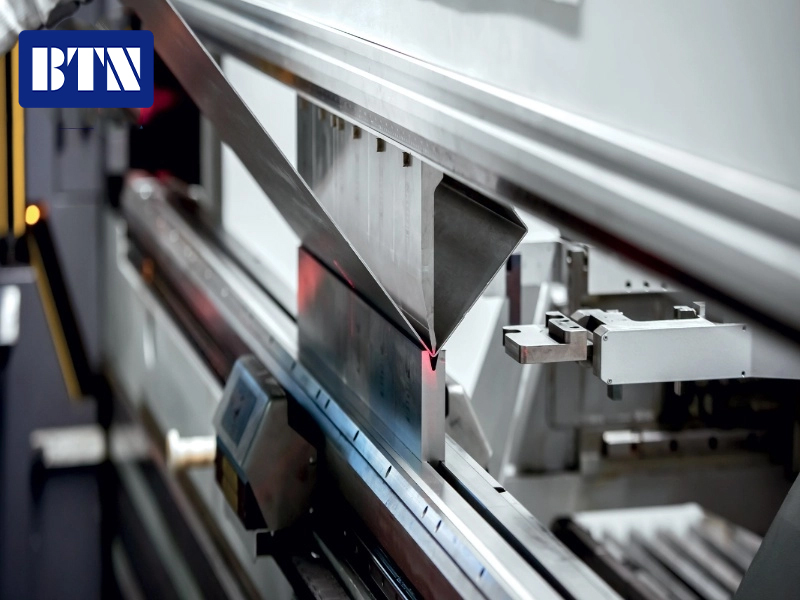
To produce quality stainless steel products, it is necessary to meet technical requirements and many other factors.
Stainless steel material quality:
- Steel grade: Stainless steel grade determines corrosion resistance, durability, weldability, and machinability. Choosing the wrong steel grade will cause the product to quickly rust, deform, or crack during use.
- Thickness: The thickness of the stainless steel sheet affects the rigidity and load-bearing capacity of the product. Stainless steel sheets that are too thin are easily warped and deformed, while stainless steel sheets that are too thick make the stamping process difficult, increasing production costs.
- Hardness: The hardness of stainless steel affects the required bending force and the elasticity of the material. Stainless steel that is too hard is prone to cracking, while stainless steel that is too soft is difficult to keep its shape after bending.
Die design:
- Bending angle: Inaccurate bending angle leads to products that do not meet requirements in terms of size and shape, affecting function and aesthetics.
- Radius of bend: Too small a radius of bend causes cracking at the bend location, while too large a radius of bend reduces the sharpness of the bending angle.
Press brake parameters:
- Punching force: Insufficient punching force causes the punching angle to not meet the requirements, the product is deformed. Too much punching force causes cracking and damages the punching mold.
- Bending speed: Bending speed that is too fast reduces the accuracy of the bending angle, causes vibration, and affects the surface quality of the product. Bending speed that is too slow increases production time and reduces productivity.
Craftsmanship:
- Experienced and skilled workers will know how to choose the right press brake parameters, adjust the press brake mold accurately, and control the press brake process to create high quality products. On the contrary, inexperienced workers are prone to make mistakes in the machine operation process, causing defective products and wasting materials.

